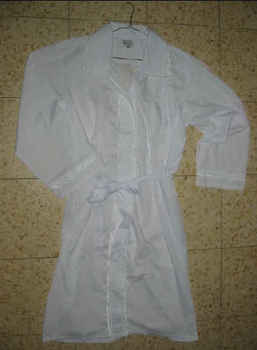Jewish Wedding Traditions
Before the actual wedding ceremony there is famous Jewish engagement party tradition called “breaking a plate” or “vort” (“word”). It is done by mothers of the bride and groom. They stand together and break a plate. This act has a symbolic meaning. Once broken plate can never be completely repaired. It is the same with human relationship.
Wedding is the happiest event in the life of the bride (“kallah”) and the groom (“chatan”). It is usually held on Sunday.
Jewish wedding has certain similarities with traditional Jewish holiday of Yom Kippur. The bride and groom fast from the dawn of wedding day until the end of wedding ceremony. The groom wears a white robe called “kittel” (kitl).
 Kittel
Kittel
According to Jewish tradition the bride and groom do not see each other in the week before the wedding. Before the wedding two wedding receptions called "Kabbalat Panim" are held by the bride's and groom's family. On the Sabbath before the wedding the groom reads from the Torah in the synagogue.
The Jews believe that bride and groom have royal status. The bride will receive guest while sitting of sort of throne. The groom will be surrounded by many guest. They will sing and make toasts.
The groom puts veil on the bride. This tradition is called “badeken”. The veil is the symbol of modesty. It shows the fact that in every person the soul and character are what really matters.
The act of putting the veil is a sign of commitment of the groom to take care and protect his bride. This tradition has its origin in the Bible when Rebecca covered her face before marrying Isaac.
Jewish wedding ceremony is held under the “chupah” (canopy). The chupah represents new home of the happy couple. The fact that the chupah has no walls shows the will of bride and groom to welcome their cousins and friends.
The chupah is very often held outside. It is done so because the Jews believe in God's blessing to the patriarch Abraham stating that his children will be as the stars of the heavens.
The groom and bride are guided to the chupah by their parents. During the wedding ceremony the bride and groom do not have any jewelry. This is done because of the belief that their relationship does not depend on any material stuff.
When under the chupah the groom circles the bride seven times. The number is chosen because the world has been created in seven days. When circling is done the groom stands at his bride's right hand side.
Two cups of wine are used at the traditional Jewish wedding ceremony. The rabbi gives a glass of blessed wine to the couple. Bride and groom share the wine.
The rabbi then reads the “Ketubah” or marriage contract. The text is written in ancient Aramaic language.
Basic responsibilities of the husband in the marriage like providing food, shelter and clothes to his wife are mentioned in the Ketubah. The husband also has to be the emotional support to his wife. The Ketubah also inlcudes right of the wife receive money if the marriage is ended because of death or divorce.
The Ketubah is signed by two witnesses. The Ketubah is usually framed and displayed somewhere in home of the newly-wed couple.
After reading of the contract, the groom puts gold ring on the first finger of his bride's left hand and with following words - “Behold; you are betrothed unto me with this ring according to the laws of Moses and Israel” announces to everyone present in the synagogue that she is his wife. After that he puts the wedding ring to the third finger.
A second glass of wine is offered to the bride and groom. The rabbi say Seven Blessings. He also praises God for marriage and wishes the couple lot of happiness in future life.
After the bride and groom drink from the glass the groom breaks the glass. The breaking of the glass symbolically reminds everyone presents of the destruction of the Temple in Jerusalem.
The broken glass also has another traditional meaning. People believe that the couple will stay together in love and happiness until the broken glass gets together again, which is forever.
The wedding reception is what follows. Everyone there is having a good time. There are numerous traditions held at the reception. Many of them are dances.
At the wedding of the last single child of the family traditional Mezinke dance is performed. The dance is also known as the Krenzel (in Yiddish “crown”) because of the flower wreath put on the mother's hair. During Mezinke dance the parents sit on chairs in the middle of dance floor. Family members and friends dance around them. Dancers kiss the parents as they pass by.
Hora or the chair dance is also very popular. Bride and groom are carried around on their chairs by some strong guests. Bride and groom are connected with a piece of cloth. Friends and family members dance around them. Famous Jewish folk song “Hava Nagila” (“Let us rejoice”) is performed with this dance. According to music experts the melody of this song is based on the Ukrainian folk song from the Bukovina region.
The “gladdening of the bride” is a traditional dance where guests dance around the bride. This dance sometimes includes “shtick” - banners, confetti, ropes made of napkins etc.
The “Mitzvah tanz” (good deed dance) is yet another dance performed at Jewish weddings. During this dance chosen guests first dance with the groom. They are introduced with a short poem describing each person by a party joker or “badchan”. The Mitzvah tanz ends with husband and wife dancing together.